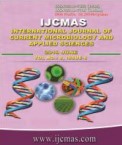


 National Academy of Agricultural Sciences (NAAS)
National Academy of Agricultural Sciences (NAAS)

|
PRINT ISSN : 2319-7692
Online ISSN : 2319-7706 Issues : 12 per year Publisher : Excellent Publishers Email : editorijcmas@gmail.com / submit@ijcmas.com Editor-in-chief: Dr.M.Prakash Index Copernicus ICV 2018: 95.39 NAAS RATING 2020: 5.38 |
Morphological markers were used to characterize 22 taro cultivars collected from four North Eastern states of India. The experiment was laid out in Randomized Block Design with three replications during 2016 and 2017. Results of principal component analysis interpreted that morphological characters like plant height, plant span, leaf area index, number of suckers, number of inflorescence/leaf axis, corm length, corm diameter, corm weight, number of cormels, cormel diameter and yield/plant contributed maximum to the variation among the cultivars and can be used as minimum descriptors for characterizing taro cultivars. The dendrogram summarizing the existence of diversity and similarities among the cultivars revealed that the cultivars were clustered mainly by plant height, petiole colour and corm weight. The cultivars were grouped into two main clusters i.e. ‘CL-I’ and ‘CL-II’. The CL-I consisted of cultivars collected from Assam, Nagaland and Kerela viz. Takali, Muktakesh, Sree Kiran, AAU-Col-32, JCC-31, Damor Dema, Boga Ahina, Kaka, Panch Mukhi, Red Garo, Naga, AAU-Col-39, Ghoti and AAU-Col-5. The CL-II consisted of cultivars collected from Meghalaya, Arunachal and Assam like Garo, Makhuti, AAU-Col-46, Arunachal-2, Koni, Ahina, Karbi Anglong and Bor-Kochu. It was found that geographical origin of the cultivars did not bear any relationship with the cultivar classification. In addition to supporting breeding and germplasm conservation, the data can serve as a baseline for correlation with other types of markers.
 |
 |
 |
 |
 |